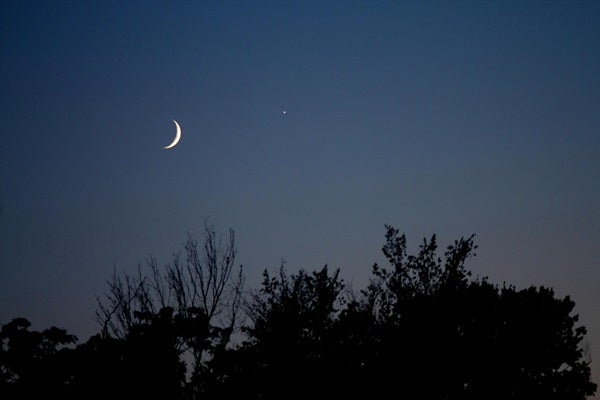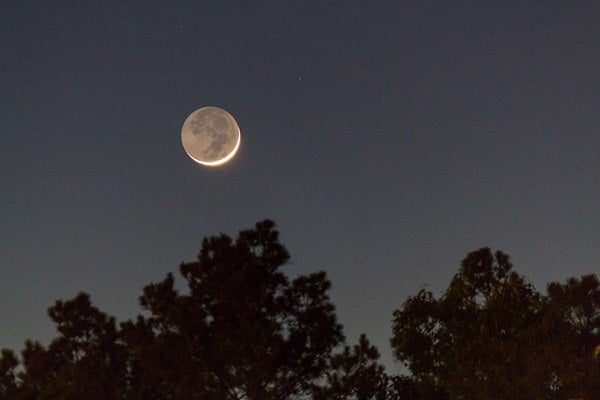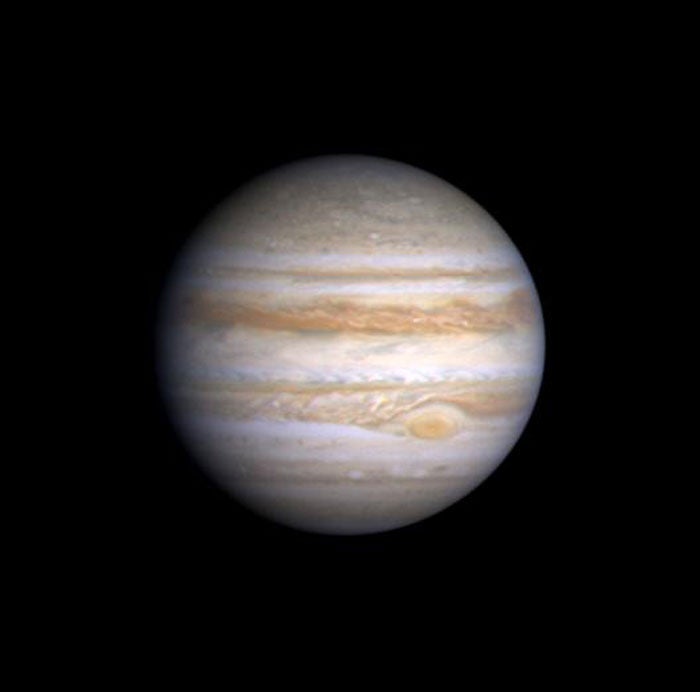The variable star Algol in Perseus reaches minimum brightness at 7:19 p.m. EST, when it shines at magnitude 3.4. If you start viewing as soon as darkness falls, you can watch it more than triple in brightness (to magnitude 2.1) over the course of about five hours. This eclipsing binary star runs through a cycle from minimum to maximum and back every 2.87 days. Algol appears high in the west after sunset and sinks slowly toward the northwestern horizon after midnight.
Saturday, March 2
If you are up before dawn this morning, you’ll see a slender crescent Moon rising less than 5° to the right of brilliant Venus. The two clear the horizon before 5 a.m. local time and climb 10° high an hour before sunrise. Venus shines at magnitude –4.1 against the background stars on the Sagittarius-Capricornus border. (The planet crosses from the former to the latter constellation today.) If you target Venus through a telescope, you’ll see a disk that spans 15″ and appears nearly three-quarters lit.
Sunday, March 3
These next few days offer skygazers an excellent chance to see the zodiacal light. From the Northern Hemisphere, late winter and early spring are great times to observe this elusive glow after sunset. It appears slightly fainter than the Milky Way, so you’ll need a clear moonless sky and an observing site located far from the city. Look for the cone-shaped glow, which has a broad base and points nearly straight up from the western horizon, after the last vestiges of twilight have faded away. The Moon stays out of the early evening sky through March 7.
Monday, March 4
Mercury remains near its best in the evening sky tonight. Look for it about 10° above the western horizon 30 minutes after sunset. (Ten degrees is roughly the angle your closed fist makes when held at arm’s length.) The innermost planet shines at magnitude 0.8, so it’s bright enough to show up against the twilight glow if you look carefully. If you don’t see it right away, scan the area with binoculars. Mercury dims and slides closer to the Sun during the next several days and will drop out of sight before week’s end. Target the planet through a telescope and you will see a 9″-diameter disk that appears less than one-quarter lit.
The Moon reaches apogee, the farthest point in its orbit around Earth, at 6:26 a.m. EST. It then lies 252,519 miles (406,391 kilometers) from Earth’s center.
Tuesday, March 5
Although Saturn passed on the opposite side of the Sun from Earth just two months ago, it already appears conspicuous in the southeast before dawn. From mid-northern latitudes, the ringed planet lies more than 10° above the horizon as twilight begins. Saturn shines at magnitude 0.6 and appears significantly brighter than any of the background stars in its host constellation, Sagittarius the Archer. A telescope shows the gas giant’s 16″-diameter disk and a spectacular ring system that spans 36″ and tilts 24° to our line of sight.
Wednesday, March 6
New Moon occurs at 11:04 a.m. EST. At its New phase, the Moon crosses the sky with the Sun and so remains hidden in our star’s glare.
Neptune is in conjunction with the Sun at 8 p.m. EST. The distant planet is hopelessly lost in the solar glare but will return to view before dawn in late April.
A young crescent Moon hung low in the west as this photographer snapped its image March 2, 2014. He noted that he barely got it amid the house’s roof, the trees, the power lines, and the hazy conditions near the horizon. Watch for another young Moon the evenings of March 7 and 8.
With an age of 4.5 billion years, “young” might not seem an appropriate word to describe our Moon. But tonight, you have an exceptional opportunity to see what astronomers call a “young Moon” — a slender crescent visible in the early evening sky. With New Moon having occurred yesterday morning, only 2 percent of our satellite’s disk appears illuminated after sunset tonight. Using binoculars, search about 5° above the western horizon 30 minutes after sunset. (If you scan 9° to the Moon’s right, you also might pick up the glow from 2nd-magnitude Mercury.) You should notice an ashen light faintly illuminating the Moon’s dark side. This is “earthshine” — sunlight reflected by Earth that reaches the Moon and then reflects back to our waiting eyes.
Asteroid 4 Vesta is in conjunction with the Sun at 5 p.m. EST. Like Neptune, this member of the main asteroid belt remains lost in our star’s glare.
Friday, March 8
If you couldn’t find the Moon yesterday evening, try again tonight. It lies 10° higher and shows a noticeably fatter — but still stunning — crescent phase. The Moon gains altitude quickly from night to night because the ecliptic — the apparent path of the Sun across the sky that the Moon and planets follow closely — makes a steep angle to the western horizon after sunset in March. It causes the Moon to gain 10° of altitude each evening despite moving only 11° eastward relative to the Sun.
Mars continues to put on a nice show these March evenings. It appears nearly 40° high in the west once twilight fades to darkness and doesn’t set until after 10:30 p.m. local time. The magnitude 1.3 Red Planet lies among the background stars of Aries the Ram. Unfortunately, Mars shows little if any detail on its 5″-diameter disk when viewed through a telescope.
Saturday, March 9
This is a good week to look for Sirius in the evening sky. The night sky’s brightest star (at magnitude –1.5) appears highest in the south just as twilight ends. It then lies about one-third of the way from the horizon to the zenith when viewed from mid-northern latitudes. (The farther south you live, the higher it appears.) If you point binoculars at Sirius, look for the pretty star cluster M41 in the same field, just 4° below the star.
Jupiter continues to grow more prominent before dawn. The giant planet shines at magnitude –2.1 and climbs 25° high in the south-southeast by the first hint of twilight. A telescope reveals Jupiter’s 37″-diameter disk and at least two conspicuous cloud belts as well as the planet’s four bright Galilean moons.
For most people in the United States and Canada, daylight saving time begins at 2 a.m. local time this morning. Set your clocks ahead one hour.












